What does the flag mean black yellow white. Imperial flag. Arrangement of colors
In 2014 State Duma deputy,
Member of the Supreme Council of the LDPR Mikhail Degtyarev prepared a bill to amend the federal constitutional law “On the State Flag of the Russian Federation,” Izvestia reported. The amendment provided for changing the existing official flag of Russia from a white-blue-red tricolor to a black-yellow-white standard.
According to the legislator,
reunification with Crimea, creation Customs Union and the growth of patriotic sentiments should occur under the flag of a victorious era in Russian history. In the explanatory note to the bill, the parliamentarian notes that during the period of widespread use of the black-yellow-white imperial flag, the territory of Russia increased significantly. It was then that the Crimea peninsula and the territory of East Prussia, Alaska, the Caucasus, Poland, the Baltic states, Central Asia and Finland.
– Under the imperial flag
we won brilliant victories, it is still capable of uniting all citizens of Russia today. The modern tricolor, which Boris Yeltsin returned in turmoil, was not discussed with the people, no research was carried out,” Degtyarev said. – We say: Russia is 1152 years old, not 23 years old, the symbols of the state should personify it great history and a great future, spiritual health determines material well-being, and not vice versa. At the same time, according to financial and economic justification, replacing flags with government institutions and on cars of diplomatic missions and officials The country is expected to spend 15.5 million rubles. The two tricolors themselves are indeed a matter of long-standing disputes between different political forces.
First mention of the flag
date back to the reign of Empress Anna Ioannovna. In 1731, in dragoon and infantry regiments, scarves were ordered to be made “according to Russian coat of arms"made of black silk with gold threads.
And someone is looking in
even earlier and claims that the first two Russian state colors appeared in our Fatherland in 1472 after the marriage of Ivan the Third to Princess Sophia Paleologus, along with the adoption of the coat of arms from the Byzantine Empire, which fell under the blows of the Turks. The Byzantine imperial banner - a golden canvas with a black eagle crowned with two crowns - becomes the state banner of Russia.
Even before the Troubles began
The state banner receives the final detail - the eagle's chest is covered with a large coat of arms with the image of St. George the Victorious. The white rider on the white horse subsequently gave legal basis the third color of the flag is white. The black-yellow-white flag combined the colors of national heraldic emblems and during the reign of Emperor Nicholas I established itself as a national symbol. For the first time in Russia, the black-yellow-white flag began to be flown on special days after 1815, following the end of Patriotic War with Napoleonic France.
In 1815
to commemorate the victory over Napoleon (and subsequently all holidays) solemn tricolor banners began to be hung on buildings; in addition, army symbols (order ribbons, banners, and cockades, which also spread among civilian officials) acquired similar colors.
In 1819
a Zholner badge appeared with the number of the battalion in the regiment, made in the form of three horizontal stripes - black, yellow, white. The “imperial banner” served as the official state flag from 1858 to 1883.
Really,
During this period, the Caucasus was finally conquered, and the Balkan campaign was successfully carried out. The Russian Empire did not suffer any major defeats. The flag, which is important for its supporters today, was never used by collaborators during the Great Patriotic War, unlike the white-blue-red banner. But there is one thing... It was during the official period that the black-yellow-white tricolor was killed for the first time in Russian history Russian Tsar - Emperor Alexander II.
“And your flag is wrong”
Why Alexander II decided to carry out a “color reset” is still an open question. There is a version that the tsar, after the unsuccessful Crimean War and the inglorious death of his father Nicholas I, decided to shake up the empire and began by changing the flag. But, in my opinion, everything is much more banal...
Just how often
happened in Russian history, one day a “scientific German” appeared... In 1857, the armorial department of the heraldry department of the empire had a new boss - Bernhard Karl (aka Boris Vasilyevich) Köhne, a famous numismatist and collector. Boris Vasilyevich, the son of a Berlin archivist, by that time had a dynamic career abroad: being a protégé of the Duke of Leuchtenberg who settled in Russia, Köhne was among the founders of the Russian Archaeological Society and received the position of curator of the numismatic department of the Hermitage.
Taking office by Köhne
noted that he popularly explained to those responsible government officials that the flag is Russian Empire wrong. It's all about the combination of colors: according to the German heraldic school, the colors of the flag must match dominant colors coat of arms And where, pray tell, is the color blue in your coat of arms?
And really – where?
The eagle is black, in gold, St. George is white... It didn’t take long to persuade the sovereign, and in the summer of 1858, Alexander II signed a fateful decree: “Description of the highest approved design of the arrangement of the emblem colors of the Empire on banners, flags and other items used for decoration during ceremonial occasions.” cases. The arrangement of these colors is horizontal, the top stripe is black, the middle stripe is yellow (or gold), and the bottom stripe is white (or silver). The first stripes correspond to the black state eagle in a yellow field, and the cockade of these two colors was founded by Emperor Paul I, while banners and other decorations of these colors were already used during the reign of Empress Anna Ioannovna. The lower stripe, white or silver, corresponds to the cockade of Peter the Great and Empress Catherine II; Emperor Alexander I, after the capture of Paris in 1814, combined the correct armorial cockade with the ancient one of Peter the Great, which corresponds to the white or silver horseman (St. George) in the Moscow coat of arms.”
What does Austria have to do with it?
The Senate approved the decree, but on the political sidelines there was some confusion: “Does this flag remind you of anything? It seems that the Austrians have the same…” And in fact, there was a similarity with the standard of the Austrian Empire. Fortunately, Austrian heraldists divided their coat of arms into only two colors - black and yellow. If he was still white, there could be an embarrassment.
Besides,
The Kingdom of Saxony had exactly the same flag (black and yellow). On the contrary, the yellow and white state standard of the Kingdom of Hanover coincided with the new Russian tricolor at the bottom. Flag of Saxony All these coincidences gave birth to Russian society unnecessary conspiracy theories.
The thing is,
that Saxony and Hanover were the patrimony of two branches of the Welf-Wettin family (from which, by the way, the current Windsor dynasty ruling in Britain comes), and legends began to emerge among the people that the Romanovs secretly became vassals of these clans - they swore allegiance to the Germans after the unsuccessful Crimean War.
But statesmen
Still, they decided to explain why they didn’t like the previous tricolor. Thus, the minister of the imperial court by the name of Adlerberg complained that the time had come to cleanse himself of “foreignness,” hinting that the former tricolor had Dutch roots. And the sovereign himself more than once advised to draw inspiration from pre-Petrine times, or even from Byzantium itself - and the Second Rome also had a yellow-black flag. At this time, many “scientific” articles were published that explained “ natural selection"yellow-black-white flag: they talked about the Byzantinism of John III, who gave Russia a two-headed eagle, about Tsar Alexei Mikhailovich, who allegedly, under threat of execution, punished the use of yellow-black colors in the state press..
Consolation flag
After the death of Alexander II
The “standard problem” was inherited by Emperor Alexander III. All this was aggravated by the fact that the German Empire, which absorbed Hanover and Saxony, and Austria, together with Italy, concluded in 1882 Triple Alliance, not the most friendly to the Russian Empire. It was necessary to do something with the state banner. In 1883, the tsar dismissed Koehne, who by that time had already created the Great Coat of Arms of the Russian Empire, the coat of arms of the Romanovs and formulated new laws in domestic heraldry. In April of the same year, the emperor returned as official former tricolor. In the “Austrian” flag, Alexander III changes the alternation of colors to white-yellow-black and gives it the status of the flag of the Romanov dynasty. For that,
To resolve the issue with the official flag of the empire, on the eve of the coronation of Nicholas II in April 1896, a special meeting was convened. It was decided that “the white-blue-red flag has every right to be called Russian or national, and its colors: white, blue and red are called state; the flag is black-orange-white and has no heraldic or historical basis.” In particular, the following were given as arguments: “If, to determine folk flowers Russia to appeal to popular taste and folk customs, to the peculiarities of the nature of Russia, then in this way the same national colors will be determined for our fatherland: white, blue, red.
Great Russian peasant
on holidays he wears a red or blue shirt, Little Russians and Belarusians wear a white one; Russian women dress in sundresses, also red and blue. In general, in the concepts of a Russian person, what is red is good and beautiful... If we add to this the white color of the snow cover, in which all of Russia is clothed for more than six months, then, based on these signs, for the emblematic expression of Russia, for the Russian folk or the state flag, the most characteristic are the colors established by the Great Peter.”
Emperor's decision
society greets with joy. But the fact that the “Kenev tricolor”, albeit in a modified form, has still been preserved, gives new food to home-grown conspiracy theorists - “Still, the Romanovs sold Mother Rus' to the Welf-Wettins...” In modern Russian symbols, the black-yellow-white flag can be found only in Kursk region– it is an element of the provincial flag.
(de jure)
Flag of the Russian Empire (1858-1883)
Flag of Russian nationalists and monarchists, flag of some modern pro-Russian organizations (1990-present)
Black-yellow-white flag of Russia- state flag of the Russian Empire (from June 11 to April 28). The use of the flag extended to government agencies and administrative buildings, while private individuals could only use the white-blue-red flag. On April 5, it was abolished de jure, and its place was taken by the modern white-blue-red flag.
At the beginning of the 20th century, the black-yellow-white flag was used (along with white-blue-red) by Russian right-wing conservative forces, adherents of the Russian Empire and the emperor, opposing revolutionaries. Today the black-yellow-white flag is used by Russian nationalist, monarchist and patriotic organizations, and football fans. It is colloquially known as the "imperial flag".
History of the flag
State banner of the Russian Empire 1742
For the first time about the use of black, yellow and white flowers It was mentioned on Russian banners at the beginning of the 18th century - during the reign of Anna Ioannovna. In the Supremely approved opinion of the Senate dated August 17, 1731, in dragoon and infantry regiments, scarves were ordered to be made “according to the Russian coat of arms” from black silk with gold, “everyone should have hats with a golden golun and with gold tassels with a black field and with a white hair bow.” . In the same Senate opinion, the white color of the cockade began to appear as the color of the “Russian field badge.” In 1742, in connection with the upcoming coronation of Empress Elizabeth Petrovna, the state banner of the Russian Empire was made, which became one of the insignias and was used at ceremonies, coronations, and burials of emperors. It consisted of a yellow panel with an image on both sides of a black double-headed eagle surrounded by oval shields with 31 coats of arms, symbolizing the kingdoms, principalities and lands mentioned in the imperial title.
The flag was first approved by decree of Emperor Alexander II on June 11, 1858; the flag design was created by Bernhard Köhne. But only in his personal order in 1865 did the tsar confirm them as “the state colors of Russia” by signing a law included in the Complete Collection of Laws of the Russian Empire under No. 33289. De facto, according to contemporaries and subsequent researchers, “in 1858 there was a change in Russian flag" and the statement of the "drawing of coat of arms flowers". Later, these colors were used to create territorial coats of arms (including the coat of arms of the Bessarabia province, approved in 1878).
The flag was used as an official flag for almost 25 years. But on the eve of the coronation Alexandra III On April 28, 1883, the Highest Order was issued, announced by the Minister of Internal Affairs “On flags for decorating buildings on special occasions.” It allowed only the white-blue-red flag to be used to decorate buildings and prohibited the use of foreign flags to decorate buildings on special occasions:
On special occasions, when it is considered possible to allow the decoration of buildings with flags, only the Russian flag was used, consisting of three stripes: the top - white, the middle - blue and the bottom - red; the use of foreign flags is allowed only in relation to buildings occupied by embassies and consulates of foreign powers, as well as for those cases when, in order to honor Members of the reigning dynasties and generally honorary representatives of foreign States coming to the Empire, it is considered necessary to decorate houses with the flags of their nationality.
A gradual process of replacing the black-yellow-white flag began. Regarding this order of April 28, 1883, the Meeting chaired by Adjutant General Konstantin Posyet recorded:
“As for the 1883 law on decorating buildings exclusively with a white-blue-red flag, from the written All-Subject report on file, the Conference saw that the Minister of Internal Affairs, State Secretary Count Tolstoy, presented two flags for the Highest approval: black-orange- white and white-blue-red, the first - as a national one and the second - as a trade one, and that the Sovereign Emperor chose the last flag from them, calling it exclusively Russian and thus, it would seem, finally resolved the issue of the unity of our state national flag.”
Black-yellow-white flags continued to be used on ceremonial days both during the coronation of Alexander III and subsequently. In 1885, black, yellow and white flags were raised as national flags at the meeting of Alexander III and the Austrian Emperor Franz Joseph in Kremsier on August 13-14. In 1887, Order No. 34 of the Military Department “Description of the National Flag...” was issued, establishing black-orange-white flags. As a result, Russia had two flags at once: black-yellow-white and white-blue-red, which led to disputes between supporters of various Russian symbols.
The provisions of the Order of 1883 were included in Article 129 of the Charter on the Prevention and Suppression of Crimes of 1890, which allowed the Kharkov police for the first time on the day of the Coronation of Their Imperial Majesties on May 15, 1892 to demand the removal of black-yellow-white flags from buildings. The ongoing discussion about the colors of the national flag required, on the eve of the coronation of Nicholas II, the convening of a Special Highly approved Meeting chaired by Adjutant General K. N. Posyet to discuss the issue of the Russian national flag. The decision of the Meeting was prepared by publishing an anonymous brochure “The Origin of Flags and Their Meaning” and distributing it to the members of the Meeting with the note “Printed by order of the Chairman of the Special Highly Approved Meeting,” the Chairman’s report repeated the provisions of this brochure.
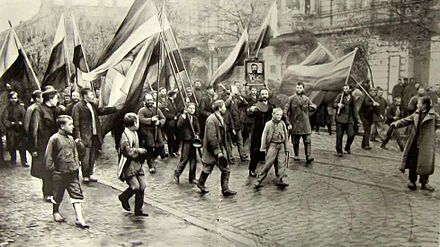
Black Hundred demonstration in Odessa, 1905. Portraits of the Emperor, national white-blue-red and imperial black-yellow-white flags
Flag colors
Description of the flag and its first official interpretation
The flag consists of three horizontal stripes: black, yellow (gold) and white. The aspect ratio of the flag is 1:2. The first official interpretation of the colors of the flag dates back precisely to the Decree of Emperor Alexander II of June 11, 1858:
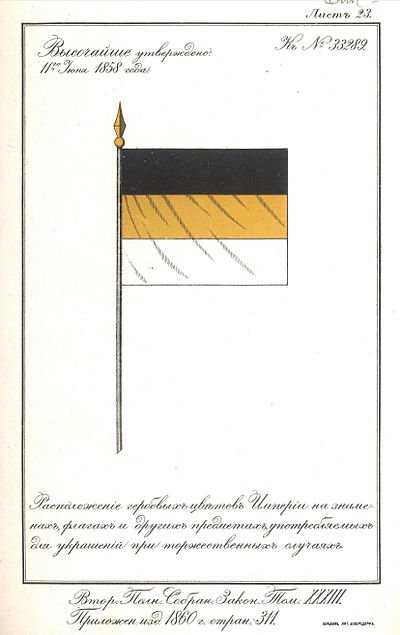
Image of the flag in the coat of arms of the Russian Empire in the appendix to the decree of Alexander II of June 11, 1858
“Description of the highest approved design of the arrangement of the emblem of the Empire on banners, flags and other items used for decoration on special occasions. The arrangement of these colors is horizontal, the top stripe is black, the middle stripe is yellow (or gold), and the bottom stripe is white (or silver). The first stripes correspond to the black state eagle in a yellow field, and the cockade of these two colors was founded by Emperor Paul I, while banners and other decorations of these colors were already used during the reign of Empress Anna Ioannovna. The lower stripe is white or silver corresponding to the cockade of Peter the Great and Empress Catherine II; Emperor Alexander I, after the capture of Paris in 1814, combined the correct armorial cockade with the ancient one of Peter the Great, which corresponds to the white or silver horseman (St. George) in the Moscow coat of arms.”
Black, yellow and white colors were carried by the flag of the largest Russian white émigré anti-Soviet organization of the 30s-early 40s of the XX century - the Russian Fascist Party. According to the party charter, the RFP party flag was flown along with the national white-blue-red flag. The rest of the RFP symbols were also used in black, yellow and white colors: the party sign, the party banner, sleeve patch and so on.
Interpretation of flowers from the point of view of the coat of arms of Russia
Later, already under Alexander II, the most known interpretation it became a little different [ unreputable source?] :
- Black color was taken from the Coat of Arms of Russia, which depicted a black double-headed eagle. The black color symbolized the greatness of Russia (especially in the East), sovereignty, state stability, the inviolability of historical borders and invincibility - in other words, the basis that determined the meaning of the existence of the Russian state.
- Yellow (or gold) color according to one version, it was also taken from the Coat of Arms of Russia (this was the field in which a double-headed eagle was depicted), according to another version, the double-headed eagle on the standard of Byzantium was golden. One way or another, the golden color and the double-headed eagle were depicted on banners even under Prince Ivan III Vasilyevich. The color yellow symbolized spirituality, the desire for moral improvement and firmness of spirit, as well as the continuity and preservation of the Orthodox faith.
- White (or silver) color was known as the color of St. George slaying a dragon with a spear. White color symbolized eternity and purity among all peoples of the world on all flags. On this flag, it symbolized the readiness of Russians to fight for their Fatherland, their family and their faith, and, on occasion, to give their lives in the name of Russia.
Relation to the flag
Supporters
Most of the supporters of the use of this flag today are modern Russian monarchists and almost all Russian nationalists (from moderate to radical). Since the flag was used as an official flag from 1858 to 1883 (but was not completely abolished until 1896), the following statement is popular among supporters of the use of the flag: “In those years when the official flag of Russia was a black, yellow and white banner, Russia never didn’t lose in wars.” The statement can be considered quite true, since during the use of the flag (if we take into account the period before 1896), Russia won the Caucasian War, the war for the liberation of the Balkan Slavs, and even a small war against England in Afghanistan.
Another argument in defense of the black-yellow-white flag is the following fact: during the Second World War, in the symbolism of Russian military and paramilitary organizations that fought on the side of Nazi Germany and its allies, a black-yellow-white flag was never found, and more often a white, blue and red banner was used. At the same time, black-yellow-white colors overshadowed the Russian fascists themselves, who fought against the USSR (including armed ones) throughout the 30s (see above). However, in the Wehrmacht troops, national units always used the state flags of the occupied countries (for example, Belgium, the Netherlands, France, Serbia, Norway, Estonia, Latvia, and so on). However, not a single Russian formation of World War II fought under the Soviet state red flag. It would be fair to say that, unlike the situation with the national connections of all other European countries, Russian national symbols (white-blue-red, black-yellow-white, and St. Andrew’s flag), both before and during World War II, always rose on the side opposing the USSR and were opposed Soviet symbols. Well-known defenders of the black-yellow-white flag include such nationalist figures as Alexander Barkashov, Alexander Belov-Potkin, Dmitry Dyomushkin and Vladimir Zhirinovsky, with the latter proposing to introduce a bill to the State Duma to approve the black-yellow-white flag of Russia as the official one.
Songs of Russian far-right groups are dedicated to the flag, such as “ Imperial flag"(group "Kolovrat"), "Imperial Flag" (group "Gr. Om."), "Kolovrat on the Sleeve" (group "Labarum"), "Imperial Flag" (group "My Daring Truth").
Opponents
Among the flag there have been and still are many of its opponents. Thus, among communists and some nationalists there is a popular opinion that this flag is not Russian or even Slavic - they consider the facts that the colors of the flag were taken from the cockades of the emperors and empresses of Russia to be fictitious. In their opinion, the de facto flag was created only on the basis of the flags of the German states - the Austrian Empire and the Kingdom of Prussia, and this is at least strange for a country that patronized the Slavs throughout Europe (traditionally blue, white and red are considered Slavic colors) [ not in the source] [unreputable source?] . However, in the conditions of the alliance of three emperors (the German-Austro-Russian alliance of the mid-19th century), the similarity of the colors of the three powers looked quite appropriate.
The number of opponents of this flag grew after the outbreak of World War I, since it was quite easy to confuse it with the flag of the warring Austria-Hungary, against which Russia fought. IN modern Russia law enforcement agencies on mass events sometimes such flags are confiscated from visitors, despite the fact that it is not included in official list extremist symbols.
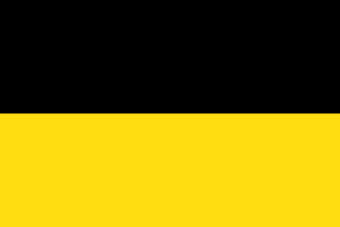 |
2 57664
There is a lot of debate about the correct arrangement of colors on the flag of the Russian Empire. The imperial flag, as we are accustomed to seeing today, consists of an upper black stripe, a middle yellow stripe and a lower white stripe. In this form it was adopted in 1858. How to correctly: black-yellow-white or white-yellow-black?
I am pleased to publish the researcha study dedicated to the history of the Imperial Flag of Russia, which today has become one of the symbols of resistance to the liberal regime and the national liberation struggle. The materials were published on the website "Moscow - Third Rome "(unfortunately, the author of this interesting material could not be identified).From the article we understand that even this symbol was turned upside down through the efforts of Judeo-Protestants, who sought to distort the meanings as much as possible. Today in the national-patriotic movement it will be difficult to explain that for many years the symbol was used “with broken logic.” Meanwhile, we know how to turn the situation against those who tried to undermine Imperial symbols and national meanings.
An upside-down flag often symbolizes that a state is in a critical situation. The Philippines is the only country in the world where the flagofficially used in two versions - regular and inverted. The reverse position of the color stripes is used when the Philippines is in a state of war, or martial law is introduced in the country.
Today Russia is virtually occupied. So let the inverted flag emphasize our position. And we will return to the logical position of the colors of the Imperial tricolor when we achieve victory. After all, as I said Confucius, "ZNacks and symbols rule the world, not words and rules » .
And now, the material of the article itself:
AND AGAIN ABOUT THE IMPERIAL FLAG... THE BATTLE FOR THE TRICOLORE
There are a lot of publications on this topic, mostly of an educational nature, where there is no justified explanation of how colors should be positioned correctly. There is only a reference to the highest approved decree No. 33289 of June 11, 1858 “On the arrangement of the coat of arms of the Empire on banners, flags and other objects used for decoration on special occasions" But the circumstances under which the decree was adopted, the current state situation and who was the author of this document are not indicated.
So until 1858 the flag was different. The order of the colors in it was as follows: starting from the top stripe - white, then yellow and black at the bottom. It existed in this form until its official adoption. Along with it there was white-blue-red... But white-yellow-black beforeAlexandra II, and after that the black-yellow-white flag was perceived by society as imperial, governmental, in contrast to the white-blue-red flag of the Russian merchant fleet. The imperial flag was associated in the minds of the people with ideas about the greatness and power of the state. It’s clear what could be majestic in a trade flag, in its very colors, which were artificially tied to Russian culturePeter I(which simply copied the colors of the Dutch flag).
Coexistence of the two flags until the 70s. XIX century was not so noticeable, but the question of the “duality” of the most important state Russian symbol is gradually beginning to arise. This duality is perceived differently by the Russian public. Ardent defenders of the Russian autocracy believed that there could be no talk of any flag other than the imperial one, legalized by the emperor: the people and the government must be united. The opposition to the tsarist regime stood under trade white-blue-red flags, which became a symbol of anti-government political movements those years. It was the “trade flag” that was defended by the so-called. “liberal” circles who shouted to the whole world that they were fighting the despotism and reactionary nature of the tsarist government, but, in fact, they were fighting against the greatness and prosperity of their own country.
During this heated controversy, Alexander II died at the hands of the revolutionaries. His son and successor, Alexander III On April 28, 1883, he gave the white-blue-red flag the status of a state flag, but at the same time without canceling and imperial. Russia now has two official state flags, which further complicates the situation. And already from April 29, 1896, the emperor Nicholas II ordered that the national and state flag be considered white-blue-red, also indicating that “ other flags should not be allowed».
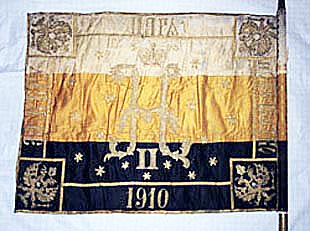 Black-yellow-white remained only with the imperial family. The emperor was “persuaded” because supposedly everyone Slavic peoples assigned such colors - and this emphasizes their “unity”. And explaining this by the fact that the black-yellow-white flag “does not have heraldic historical foundations in Russia” to be considered a cloth bearing Russian national colors. This begs the question, what kind of historical basis does the trade flag have?
Black-yellow-white remained only with the imperial family. The emperor was “persuaded” because supposedly everyone Slavic peoples assigned such colors - and this emphasizes their “unity”. And explaining this by the fact that the black-yellow-white flag “does not have heraldic historical foundations in Russia” to be considered a cloth bearing Russian national colors. This begs the question, what kind of historical basis does the trade flag have?
But let's return to the white-yellow-black banner. That is, then, before adoption, the white-yellow-black flag was simply turned over.
Can be traced back to the “coup” and the author - Bernhard Karl Köhne(he will be discussed at the end of the article in order to fully understand what kind of person got involved in “correcting” Russian heraldry). Upon his accession to the throne, Alexander II decided, among other things, to put the state symbols in order - and to bring them into line with pan-European heraldic standards.
This was to be done by Baron Bernhard-Karl Köhne, who was appointed head of the stamp department in 1857. Köhne was born into the family of a secret state archivist, a Berlin Jew, a heretic who converted to the Reformed religion. He came to Russia under the patronage. In heraldic historiography he earned a sharp negative assessment, despite his vigorous activity.
But be that as it may, the flag was accepted and in this form it existed until 1910, when monarchists raised the question of the “correctness” of the flag, since the 300th anniversary of the House was approaching Romanovs.
A special meeting was formed to clarify the issue “about the state Russian national colors.” It worked for 5 years, and the majority of participants voted for the return of the imperial white-yellow-black flag with the “correct” arrangement of colors as the main, state flag.
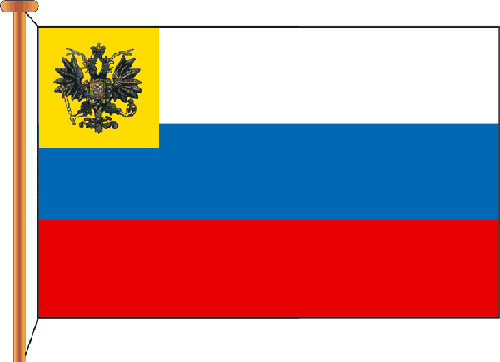 For some reason and why, it is not clear, but they made a compromise - the result was a symbiosis of two competing flags: the eclectic white-blue-red flag had a yellow square with a black double-headed eagle in the upper corner. We fought a little with this one in the First World War. Further, the history of the imperial flag ends for a well-known reason.
For some reason and why, it is not clear, but they made a compromise - the result was a symbiosis of two competing flags: the eclectic white-blue-red flag had a yellow square with a black double-headed eagle in the upper corner. We fought a little with this one in the First World War. Further, the history of the imperial flag ends for a well-known reason.
IN in heraldry, an inverted flag means mourning
, Köhne knew this very well, heading the heraldic department of the Empire. The death of the Russian emperors confirmed this. In maritime practice, an inverted flag means that the ship is in distress. It is clear that colors are still confused and flags are hung upside down, consciously and unconsciously, but for this to happen at the state level and with many years of struggle, we need special efforts special people.
The existence of the white-yellow-black flag is confirmed by newsreels, but they are treated differently due to the black and white film. Supporters of the black-yellow-white flag explain that on the set of the white-blue-red flag, without being embarrassed by the simple experience of comparing colors, when converting colored flags into black and white mode using any well-known graphic editor.
Also, the tricolor in the white-yellow-black arrangement can be seen in artists’ paintings.
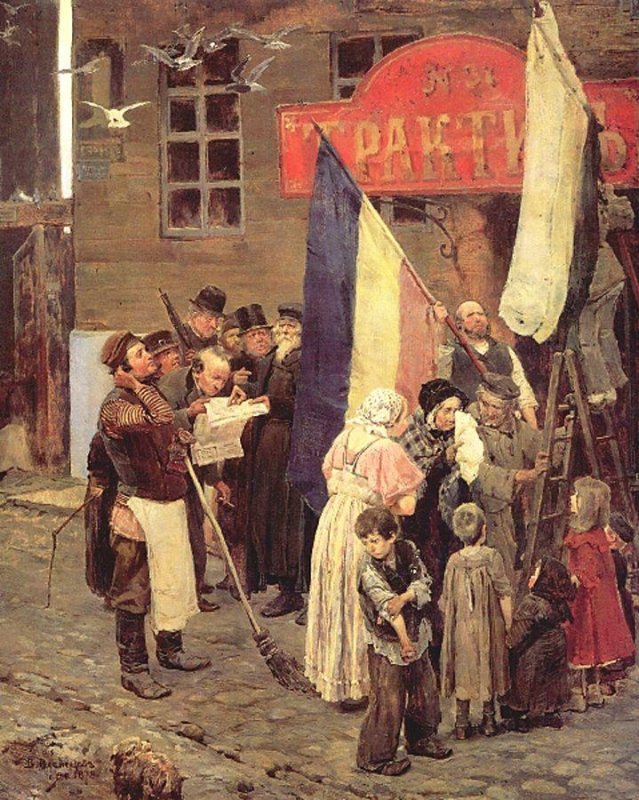 (Vasnetsov V. M.
“News of the capture of Kars” 1878)
(Vasnetsov V. M.
“News of the capture of Kars” 1878)
In the picture Vasnetsovadedicated to the Russian-Turkish war, a white-yellow-black flag is installed. Interesting fact: the painting dates back to 1878, that is, it was painted 20 years after the release of statement No. 33289 “about the arrangement of coat of arms colors” in which they were changed the other way around. It turns out that the people still used uninverted white-yellow-black flags.
(In the center, either the (blue-yellow-red) flag of the United Principality of Wallachia and Moldavia, an ally of the Russian Empire in Russian-Turkish War(1877-1878), or Pan-Slavic (blue-white-red) flag - difficulties in determining color from reproduction middle zone. In 1848, at the Pan-Slavic Congress in Prague, the Slavic peoples adopted a common Pan-Slavic flag, repeating the colors of the Russian (white-blue-red) flag).
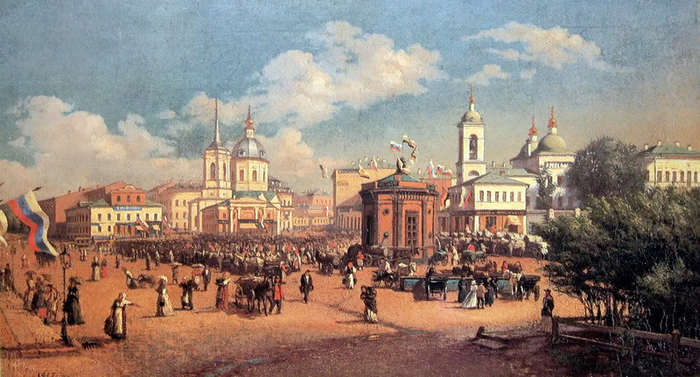 And here is the picture Rozanova"Fair on Arbat Square." White, yellow and black flags can be seen waving on the roofs of buildings. And along with them are white, blue and red. The picture was painted just during the coexistence of the two flags.
And here is the picture Rozanova"Fair on Arbat Square." White, yellow and black flags can be seen waving on the roofs of buildings. And along with them are white, blue and red. The picture was painted just during the coexistence of the two flags.
(Rozanov , "Fair on Arbat Square")
No matter how they explain the location of the black stripe at the top: this is the incomprehensibility of God (how is God light?), and the greatness of the Empire, and the color of Spirituality (referring to the monastic robe). Also interpreted as: black - monasticism, yellow - gold of icons, white - purity of the soul. But all this is from the category folk interpretations“Whoever comes up with it.”
At the same time, the most main point, that the colors of the imperial flag should be identical to the words expressing our entire Slavic essence: Orthodoxy, Autocracy, Nationality. Or to put it another way: Church, King, Kingdom. What color goes with each of these words? The answer is obvious.
In 1858, along with the flag, changes were made to the state emblem. Koehne created it the way we are used to seeing it. Although under Nicholas I it was different.
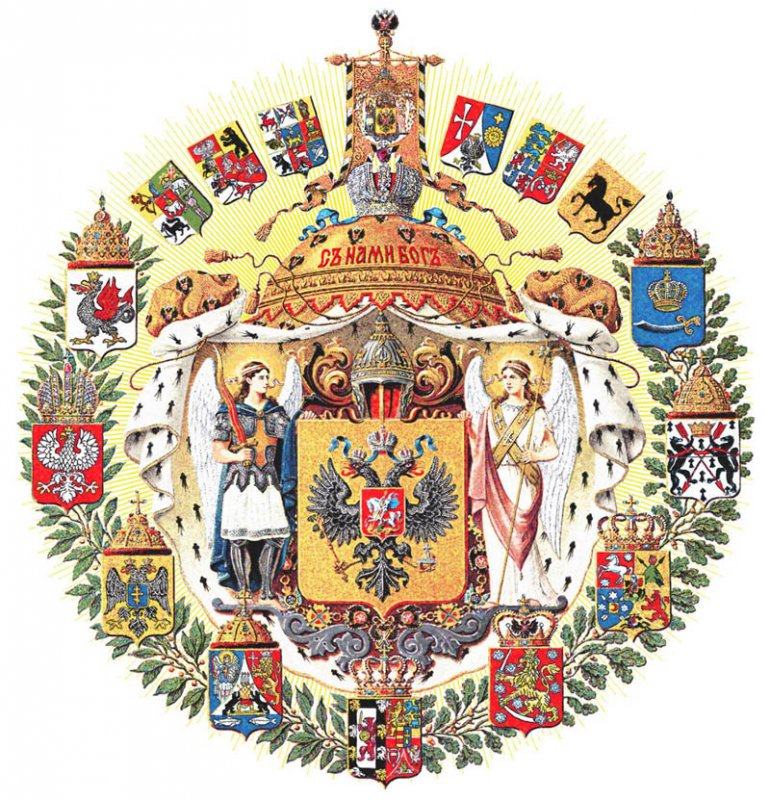 Coat of arms of Köhne, 1858
Coat of arms of Köhne, 1858
For example, the Coat of Arms depicted on coins.
Here are the Nikolaev coins, 1858
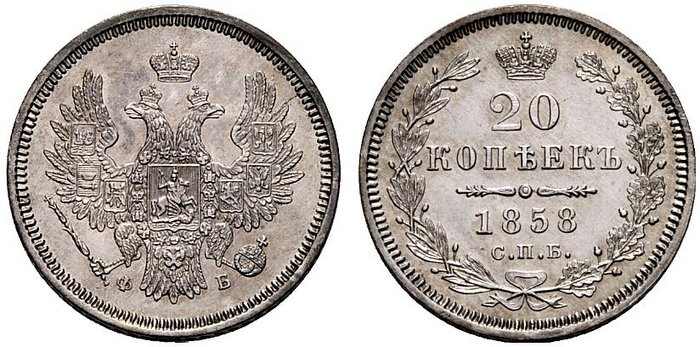
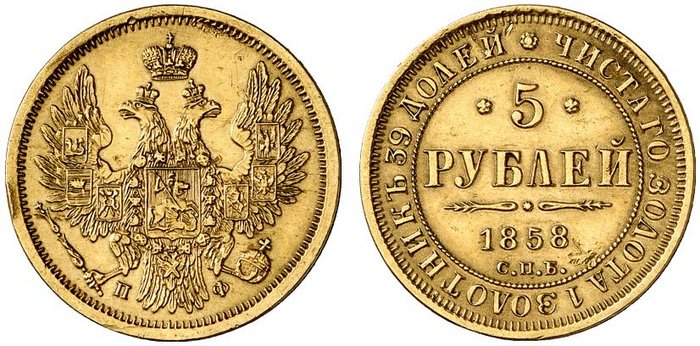
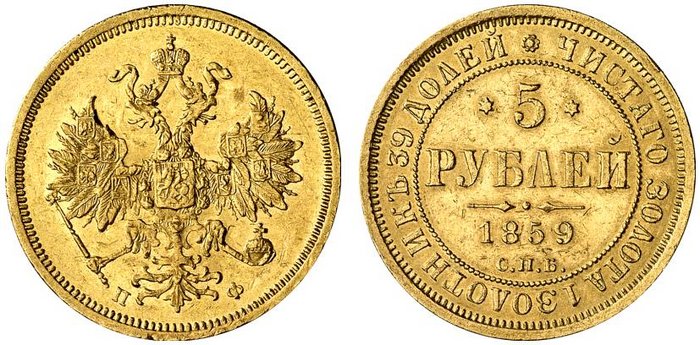 And here is a coin from 1859 of Alexander II ( the reign of Alexander II, whose years were called the “era of great reforms”, for Russian Jews, as well as for the country as a whole, was a sharp contrast to the previous period: reforms in the economy, relative political freedoms, rapid development of industry - all this, as a century earlier in Prussia, created the conditions for Jewish assimilation, which never happened). Here you can clearly see how accurately the eagle was “licked” from the Habsburg coat of arms. A particularly striking detail is the eagle's tail. And all this in one year with the change of the flag. Magendovids (six-pointed stars) also appeared on coins. Since the Masons are great symbolists, they just wanted to add at least a drop of tar to our heraldry.
And here is a coin from 1859 of Alexander II ( the reign of Alexander II, whose years were called the “era of great reforms”, for Russian Jews, as well as for the country as a whole, was a sharp contrast to the previous period: reforms in the economy, relative political freedoms, rapid development of industry - all this, as a century earlier in Prussia, created the conditions for Jewish assimilation, which never happened). Here you can clearly see how accurately the eagle was “licked” from the Habsburg coat of arms. A particularly striking detail is the eagle's tail. And all this in one year with the change of the flag. Magendovids (six-pointed stars) also appeared on coins. Since the Masons are great symbolists, they just wanted to add at least a drop of tar to our heraldry.
A few more coins for comparison:
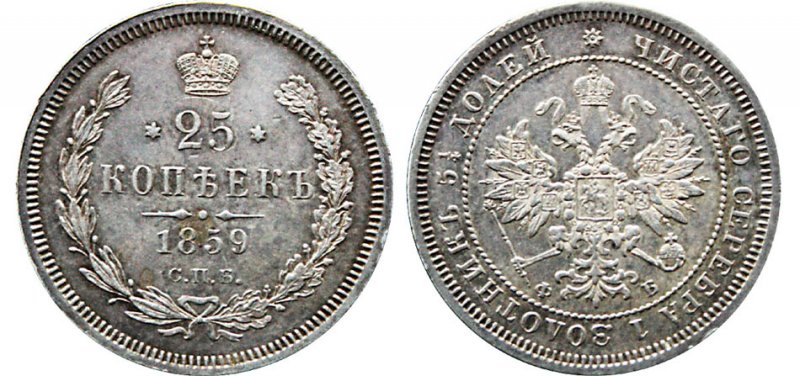
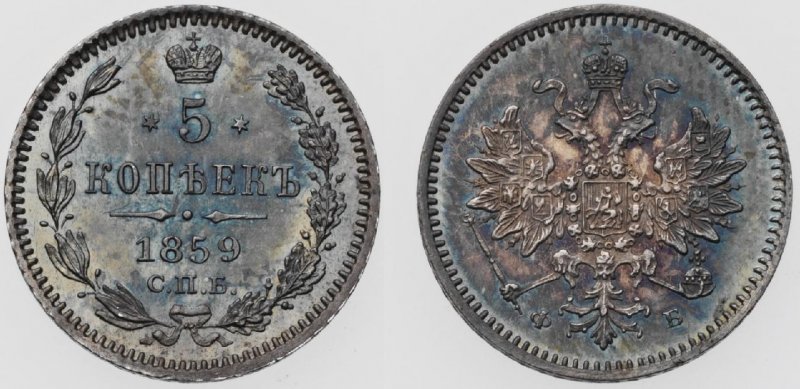
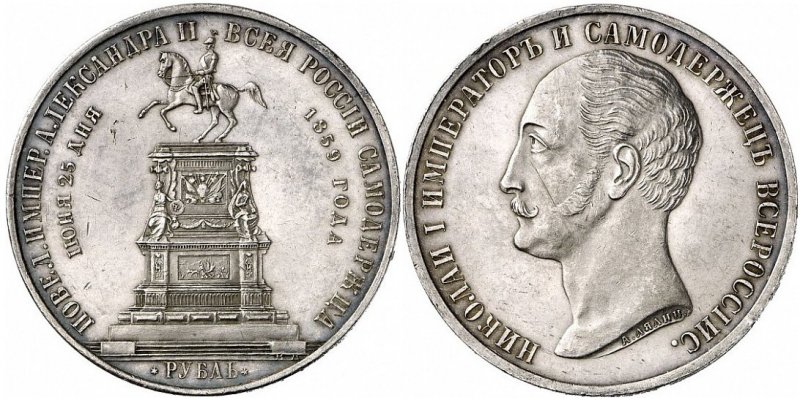 Back in 1959, they issued a commemorative coin and medal “ Monument to Emperor Nicholas I on horseback».
Back in 1959, they issued a commemorative coin and medal “ Monument to Emperor Nicholas I on horseback».
Magendavids are now so small that they can only be seen under a magnifying glass
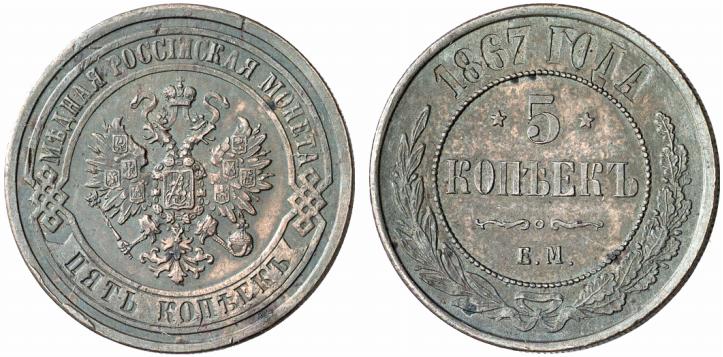 The copper coins were updated, the design changed radically, the stars there are “Soviet” - pentacles.
The copper coins were updated, the design changed radically, the stars there are “Soviet” - pentacles.
The image below shows the similarity of the coat of arms that Koehne “composed” with the coat of arms of the Habsburgs.
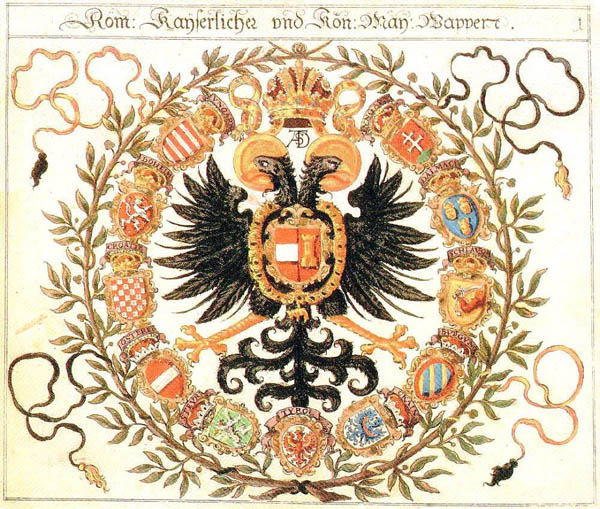 Habsburg coat of arms
Habsburg coat of arms
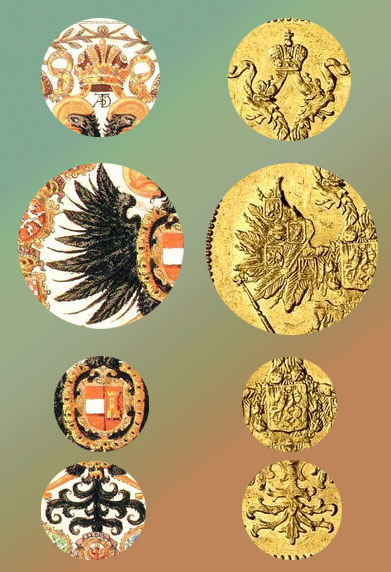 For comparison:
For comparison:
1) The crown acquired a ribbon (more like a snake); before this, this ribbon had never been used in Russian heraldry;
2)
Previously, the wings on all eagles had a lot of feathers, but now they began to absolutely copy the Habsburgs, even in design, between the large feathers and here and there, there are small feathers. At the same time, our eagle turned out to have 6 feathers, versus 7;
3)
The combination of the coat of arms and the chain, although this arrangement had been used previously, on all previous coins the order was clearly visible Holy Apostle Andrew the First-Called, now it’s just a chain, like the Habsburgs themselves;
4)
Tail. Everything is clear without comment.
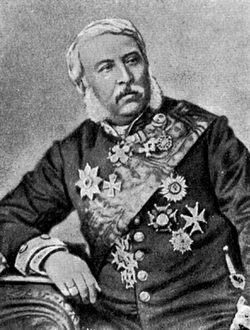 FOR REFERENCE: AUTHOR OF THE COVERUP OF THE FLAG OF THE RUSSIAN EMPIRE
FOR REFERENCE: AUTHOR OF THE COVERUP OF THE FLAG OF THE RUSSIAN EMPIRE
Bernhard Karl(in Russia "Boris Vasilievich") Koehne
(4/16.7.1817, Berlin - 5.2.1886, Würzburg, Bavaria) was born into the family of a secret state archivist, a Berlin Jew who adopted the Reformed religion (Köhne himself and his son remained Protestants, despite the fact that they connected their lives with Russia, only his grandson became Orthodox).
He became interested in numismatics early and published his first work in this field (“Coinage of the City of Berlin”) at the age of 20, when he was still a student at a Berlin gymnasium. He was one of the active figures, and then the secretary of the Berlin Numismatic Society. In 1841–1846 supervised the publication of a journal on numismatics, sphragistics and heraldry.
Köhne met Russia in absentia back in the early 1840s. Famous numismatist Yakov Yakovlevich Reichel, who served in the Expedition for the Procurement of State Papers, the owner of one of the largest numismatic collections, drew attention to young man, who soon became his assistant in collecting and “representative” in German numismatic circles. After completing his university course, Koehne came to St. Petersburg for the first time.
He returned to Berlin with a firm desire to enter the Russian service and applied for the then vacant chair of archeology at the St. Petersburg Academy of Sciences (which never happened). As a result of Reichel’s patronage, on March 27, 1845, Koehne was appointed assistant to the head of the First Department of the Imperial Hermitage (the First Department included collections of antiques and coins, it was headed by a major numismatist Florian Antonovich Gilles) with the rank of collegiate assessor. By the end of his life, Koehne had risen to the rank of Privy Councilor (1876).
In St. Petersburg, Koehne developed a vigorous activity. The persistent desire to get into the Academy of Sciences, moreover, in the archaeological “direction”, stimulated not only his active study of archeology, but also his no less active organizational work. In an effort to gain the necessary weight in scientific circles, Koehne initiated the creation of a special numismatic society in Russia, but since archeology inevitably attracted him, he combined these two sciences under one “administrative” name - this is how the Archaeological-Numismatic Society appeared in St. Petersburg (later the Russian Archaeological Society ).
Köhne sought to promote himself and society on a European scale. It contained all the correspondence with foreign scientists. And foreign scientific societies invariably accepted him as their members, so that by the end of his life he was a member of 30 foreign societies and academies (he never got into the St. Petersburg one). By the way, orientation towards the West led to the fact that Koehne tried not to allow reports in Russian at meetings (only in French and German), and only after the ethnographer and archaeologist joined the society Ivan Petrovich Sakharov(1807–1863), the Russian language was restored to its rights.
The second half of the 1850s was Koehne’s “triumph” in Heraldry, when in 1856 he created the Great State Emblem of the Empire, and in June 1857 he became the manager of the Armorial Department at the department (with retention in office for the Hermitage). Heading the whole practical work in the field of Russian heraldry, Koehne over the next years began a large-scale heraldic reform, trying to unify and give consistency to the body of Russian family and territorial coats of arms by bringing them into line with the rules of European heraldry (for example, turning the figures to the right heraldic side; replacing some that seemed to Koehne not suitable for heraldry, figures on others, etc.) and the introduction of new principles and elements (placement of the provincial coat of arms in the free part of the city, a system of emblems of the external part of territorial and city coats of arms, reflecting their status, etc.).
Koene is also the author of the black-yellow(gold)-white state Russian flag, designed in the colors of the main figure and the field of the shield of the Russian state emblem (black eagle in a golden field).
Köhne’s career in the Russian Archaeological Society ended with the arrival of the new august leader of the Grand Duke Konstantin Nikolaevich. He did not approve the election of Koehne as secretary of the third department of the society (the only case in the entire history of the society), as a result of which at the beginning of 1853 Koehne left its ranks. Konstantin Nikolaevich had a persistent dislike for Koena. In particular, he disapproved of the draft state emblem of 1856–1857.
On October 15, 1862, Köhne was allowed to accept the baronial title, granted on May 12/24 of the same year by the ruler (due to the prince’s infancy Henry XXII) Principality of Reuss-Greiz Carolina-Amalia. In the literature one can find a statement that Koehne owes this title to the state emblem of the Russian Empire he created, but this data needs confirmation. Most likely, the enterprising numismatist simply bought the rights to this title and thus became, probably, the only Baron “Reuss-Greizsky” in Russia.
At the same time, it can be firmly stated that Nicholas II and Tsarevich Alexei understood the problem of the state flag of the Russian Empire and intended to bring its colors to their original form, i.e. white-yellow-black. This is confirmed by the fact that the banner of the Livadia-Yalta amusement company named after Tsarevich Alexei consisted of white, yellow and black stripes.
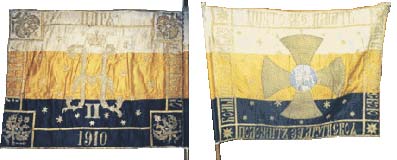 In addition, for the 300th anniversary of the House of Romanov, Tsar Nicholas II approved an anniversary medal using the colors: White-Yellow-Black.
In addition, for the 300th anniversary of the House of Romanov, Tsar Nicholas II approved an anniversary medal using the colors: White-Yellow-Black.
Well, this is another revealing lesson - already on state symbols - do not allow goats into the garden. But we already know how to turn this weapon against themselves.
There was no official state flag in Russia for a very long time, although sometimes the white-blue-red tricolor was perceived as the state flag - after all, it was raised on merchant ships and was most often seen abroad. But on June 11, 1858, Emperor Alexander II approved the first official state flag of the Russian Empire - a black, yellow and white banner.
Where do these colors come from? Their choice was partly justified by the traditions of Western European heraldry, according to which the colors of the flags most often repeated the colors of the coats of arms of the ruling dynasties in these countries. Likewise, on the Russian flag, the upper black and middle yellow stripes corresponded to the black double-headed eagle and the yellow field of the state coat of arms, and the lower white stripes corresponded to the cockade of Peter I and the white horseman of St. George, the patron saint of the kings of Moscow and Moscow.
But the flag of dynastic colors did not last long. Emperor Alexander III on May 7, 1883 ordered the white-blue-red tricolor to be hung on ceremonial occasions, and on April 5, 1896, a special meeting decided: the tricolor is the “national and state flag” of the Russian Empire. The colors were explained by the title of the emperor - “all Great, and White and Little Russia”: red corresponded to the Great Russians, blue to the Little Russians, white to the Belarusians.
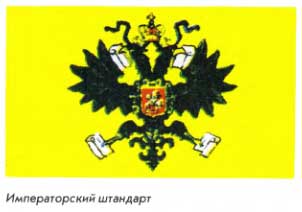
At the end of the 19th century. flags, standards and pennants were unified, white, blue and red colors replaced black, gold and white. However, the struggle between supporters of the two flags did not stop; the question of which of them should be the state one continued to be discussed. Monarchist-minded circles insisted on the return of the dynastic flag, while liberals advocated maintaining the white-blue-red flag.
The First World War prevented his final decision, and the tricolor was preserved as the state flag, and black-yellow-white as the dynastic flag of the emperors.
The First World War gave birth to another flag, combining the tricolor and the imperial standard and symbolizing the unity of the king and the people. In it, the white and blue stripes on the roof (in the upper left corner of the panel) were covered by a yellow square with a double-headed eagle.
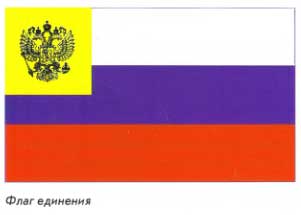
So until 1858 the flag was different. The order of the colors in it was as follows: starting from the top stripe - white, then yellow and black at the bottom. It existed in this form until its official adoption. Along with it, there was a white-blue-red one, which from April 29, 1896, Emperor Nicholas II ordered to be considered the National and State flag. The emperor was “persuaded” because supposedly all Slavic peoples were assigned such colors - and this emphasizes their “unity”.
That is, then, before adoption, the white-yellow-black flag was simply turned over.
The “coup” can also be traced to the author - Bernhard Karl Köhne. He was born into the family of a secret state archivist, a Berlin Jew who converted to the Reformed religion. He came to Russia under the patronage. In heraldic historiography he earned a sharp negative assessment, despite his vigorous activity. Need I say that they didn’t speak Russian in the department he headed? However, at that time very little Russian was spoken in high bureaucratic circles.
But be that as it may, the flag was accepted and in this form it existed until 1910, when monarchists raised the question of the “correctness” of the flag, since the 300th anniversary of the House of Romanov was approaching.
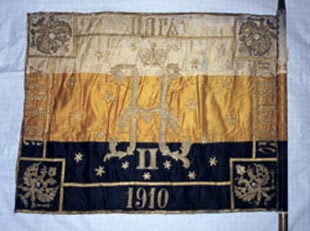
A special meeting was formed to clarify the issue “about the state Russian national colors.” It worked for 5 years, and the majority of participants voted for the return of the imperial white-yellow-black flag with the “correct” arrangement of colors as the main, state flag.
For some reason and why - it is not clear, but they made a compromise - the result was a symbiosis of two competing flags: the eclectic white-blue-red flag had a yellow square with a black double-headed eagle in the upper corner. We had a little fight with this one in that world war. Further, the history of the imperial flag ends for a well-known reason.
In heraldry, an inverted flag means mourning, Köhne knew this very well, heading the heraldic department of the Empire. The death of the Russian emperors confirmed this. In maritime practice, an inverted flag means that the ship is in distress.
It is clear that colors are still confused and flags are hung upside down, consciously and unconsciously, but for this to happen at the state level and with many years of struggle, special efforts of special people are needed.
Before Tsar Alexei Mikhailovich, Russia did not have a single state banner. Russian people in different circumstances used different symbols to express their folk, Russian essence - banners, icons, Cossack horsetails, banners of Streltsy regiments, etc. Apparently there was no pressing need for such a symbol; its functions were performed by the coat of arms of the Russian state - a double-headed eagle. The Russian state flag also grew from similar symbols, and it took shape under Tsar Alexei Mikhailovich (father of Peter the Great).
In 1668, Tsar Alexei Mikhailovich ordered the creation of an armorial ("herital") banner, which contained almost all the official and unofficial symbols of the Orthodox Russian kingdom.
It was trapezoidal, with a wide crimson border with the image of Christ in the upper part among two eight-pointed Russian crosses with a foot. On a large white “kerchief” (1.69 m wide, 4.36 m long at the top) a golden double-headed eagle with two crowns, a scepter and an orb was placed, on the eagle’s chest shield there was a “king piercing a serpent with a spear.” Under the eagle was a view of the Kremlin with the inscription “Moscow”, and all around were the regional coats of arms of the kingdom. All this and also full title king along the border, revealed the political program of the government - the unification of all lands Ancient Rus' under the rule of Orthodox Moscow.
The banner took part during state and church ceremonies and served as a royal standard - it was worn in front of the king on campaigns.
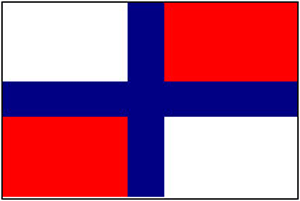 In 1667-1669, in the village of Dedinovo near Moscow, on the Oka River, by order of Tsar Alexei Mikhailovich, a small military flotilla was built to protect merchant ships on the Volga and the Caspian Sea. The main one among the ships being built was the three-masted ship "Eagle". The warship needed an identification sign - a flag. The captain of the "Eagle" D. Butler turned to the government with the question of which flag to fly on the ship. The question turned out to be very relevant, and Alexei Mikhailovich had to decide what the state colors of Russia would be. White, red and blue colors. The developers proceeded from the fact that, according to Russian everyday concepts, the color red meant courage, heroism, and fire; blue - sky, spirituality, faith; white - peace, purity, truth, nobility.
In 1667-1669, in the village of Dedinovo near Moscow, on the Oka River, by order of Tsar Alexei Mikhailovich, a small military flotilla was built to protect merchant ships on the Volga and the Caspian Sea. The main one among the ships being built was the three-masted ship "Eagle". The warship needed an identification sign - a flag. The captain of the "Eagle" D. Butler turned to the government with the question of which flag to fly on the ship. The question turned out to be very relevant, and Alexei Mikhailovich had to decide what the state colors of Russia would be. White, red and blue colors. The developers proceeded from the fact that, according to Russian everyday concepts, the color red meant courage, heroism, and fire; blue - sky, spirituality, faith; white - peace, purity, truth, nobility.
A document from 1668 has been preserved, which states that silk fabric in white, blue and red was issued for a large banner “that lives in the stern.”
In the book “Ship Flags” by Karl Allard, published in Amsterdam back in 1695, this flag is described as follows: “the Moscow flag, defined by a blue cross, the first and fourth quarters are white, the second and third are red.” The first Russian naval flag was originally striped (it was also called a half-length flag), similar to the modern Russian State Flag.
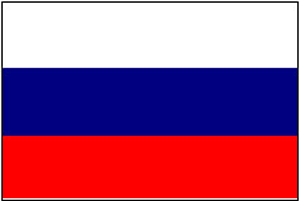 In 1696 - 1701, Peter the Great created many sketches and designs of flags and pennants. He did not change the state colors, but determined the exact location of the horizontal stripes, coinciding with the ancient understanding of the structure of the world: below - physical, carnal (red); above - heavenly (blue); even higher - divine (white). January 20, 1705 can be considered the birthday of the future national flag: a decree was issued on behalf of the tsar, according to which the white-blue-red flag (“besik” or “besikr”) became the flag of merchant ships. It will be called provisions, trade, merchant, commercial, “philistine”, civil and, finally, Russian national. The white, blue and red Russian national flag was also a symbol of Slavic solidarity, the struggle of the Slavs against enslavement by Austria-Hungary and Turkey in the 19th century. The state flags of Slovakia, Slovenia, and Serbia originate from the Russian white-blue-red banner.
In 1696 - 1701, Peter the Great created many sketches and designs of flags and pennants. He did not change the state colors, but determined the exact location of the horizontal stripes, coinciding with the ancient understanding of the structure of the world: below - physical, carnal (red); above - heavenly (blue); even higher - divine (white). January 20, 1705 can be considered the birthday of the future national flag: a decree was issued on behalf of the tsar, according to which the white-blue-red flag (“besik” or “besikr”) became the flag of merchant ships. It will be called provisions, trade, merchant, commercial, “philistine”, civil and, finally, Russian national. The white, blue and red Russian national flag was also a symbol of Slavic solidarity, the struggle of the Slavs against enslavement by Austria-Hungary and Turkey in the 19th century. The state flags of Slovakia, Slovenia, and Serbia originate from the Russian white-blue-red banner.
Demonstration of the white-blue-red flag in international waters 1696 - 1700. suggests that it was considered state.
Almost at the same time, on turn of the XVII and XVIII centuries, Peter I gave the Russian to the navy the new flag is "Andreevsky". The white color of the field and the blue cross of the St. Andrew's flag were not chosen by Peter I by chance. For the military flag of the fleet, the tsar took the colors of the top two, most honorable stripes of the white-blue-red flag.
After the death of Peter the Great, the question of a state banner was not raised, although in one of Anna Ioannovna’s decrees black and gold (yellow) colors were called state colors. The coronation banner of Elizabeth Petrovna was “built” in these same colors.
Each of the Russian monarchs made their own amendments to state symbols. During the reign of each of them, noticeable changes took place in Russian society, the country's borders expanded, social transformations were carried out, and the status of the Russian state changed.
WITH early XIX centuries, flags have become one of the most expressive symbols of all leading states. A tradition has emerged of decorating streets and buildings with state flags during major celebrations. Obviously, thanks to the merchant fleet, the Russian white-blue-red flag was well known abroad. When the Russian army entered Paris in March 1814, Parisians hung white, blue and red banners, considering them Russian. In 1856, to celebrate the conclusion of the Paris Peace Treaty after the end of the Crimean War, houses were decorated with the flags of the warring powers. Russian white-blue-red flags were called the flags of "Russian national colors". For the first time, the Russian “national” flag was officially approved in 1858. By this time, the musical symbol of the Russian Empire had already been created - the anthem “God Save the Tsar!” (1833). In 1857, the drawings of the state emblem were also officially approved. On June 11, 1858, Emperor Alexander II approved the design of “heraldry flowers on banners, flags and other items used for decoration on special occasions.” The law established that “the arrangement of these colors is horizontal, the upper stripe is black, the middle one is yellow (or gold), and the bottom one is silver (or white).” To justify the colors of the flag, they were associated with the historical colors of the state emblem: a black eagle in a yellow (golden) field and a white horseman in the Moscow coat of arms. In the text of the law, this explanation sounded as follows: “The first stripes correspond to the black state eagle in a yellow or gold field and the cockade of these two colors was founded by Emperor Paul I, while banners and other decorations of these colors were already used during the reign of Empress Anna Ioannovna. The lower stripe is white or silver corresponding to the cockade of Peter the Great and Empress Catherine II; Emperor Alexander I, after the capture of Paris in 1814, combined the correct armorial cockade with the ancient one of Peter the Great, which corresponds to the white or silver horseman (St. George) in the Moscow coat of arms.”
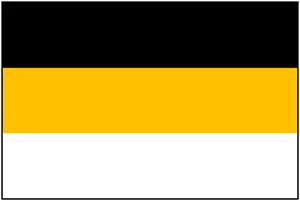 Despite the complexity and ambiguity of such an explanation, the description of the coat of arms claimed the Russian - "national" - tricolor black-yellow-white flag. This flag entered the system of European flags of the 19th century. Gold, black and white colors used in the design of banners and uniforms Russian army. And yet, both in Russia and abroad, two samples were hung as the state flag: white-blue-red and black-yellow-white.
Despite the complexity and ambiguity of such an explanation, the description of the coat of arms claimed the Russian - "national" - tricolor black-yellow-white flag. This flag entered the system of European flags of the 19th century. Gold, black and white colors used in the design of banners and uniforms Russian army. And yet, both in Russia and abroad, two samples were hung as the state flag: white-blue-red and black-yellow-white.
Coexistence of the two flags until the 70s. The 19th century was not so noticeable, but the question of the “duality” of the most important state Russian symbol is gradually beginning to arise. This duality is also perceived differently by the Russian public.
Vladimir Ivanovich Dal, honorary academician of the St. Petersburg Academy of Sciences, author of the famous “ Explanatory dictionary living Great Russian language,” for example, asked: “All the peoples of Europe know their colors, suits, paints - we don’t know them and confuse them, raising multi-colored flags at random. We don't have a national color. What colors should we pick up and wear, what colors should we decorate buildings with, etc. during peaceful public celebrations?”
Ardent defenders of the “Russian autocracy” believed that there could be no talk in the state of any flag other than one legalized by the emperor: the people and the government must be united. They were also frightened by red banners, which at that time began to appear on the streets of the capital as a symbol of anti-government political movements.
“Independently” white, blue and red banners went out onto the city streets: they surrounded the monument to Pushkin in Moscow on June 6, 1889, a monument to the grenadiers who fell near Plevna. Projects of the national flag appeared on the pages of the press.
Under these conditions, Emperor Alexander III hastened to declare his desire “to see national flags in the Russian capital....” And on April 28, 1883, a legislative decree of Alexander III “On flags for decorating buildings on special occasions” appeared. It said that “on those solemn occasions when it is considered possible to decorate buildings with flags, only the Russian flag was used, consisting of three stripes: the upper one is white, the middle one is blue and the lower one is red.” However, the imperial colors were not completely abandoned, because there was no Imperial command to abolish the black-yellow-white flag. Flags of black-yellow-white and white-blue-red were hung on the streets as symbols of the Russian state.
The current situation marked the beginning of a discussion about Russian state national colors. This discussion was associated not only with increased interest in history, but primarily with the need to understand modern processes and the future of Russia.
Before the coronation of Nicholas II in March 1896, on his instructions, “a special meeting was convened to consider the issue of the Russian national flag, which came to the unanimous opinion that the white-blue-red flag has every right to be called Russian, or national, and the colors his: white, blue and red - are called state ones. The white-blue-red flag was installed uniformly for the entire Russian Empire.
What prompted the tsar to quickly resolve a difficult issue for Russia on the eve of his coronation?
First of all, Nicholas II was, of course, an educated person, he understood many issues, including the history of the state. And in the situation late XIX V. To unite all categories of the population, a truly Russian symbol was required. This was the white-blue-red flag introduced by the great sovereign who glorified Russia. The symbol that unites the people and the tsar, the white-blue-red flag of Peter the Great, was intended by the government to be an alternative to the ever-increasing use of the red flag.
Sources: State flag Russian Federation// Coat of arms, flag and anthem of Russia. Studying the state symbols of the Russian Federation at school / comp. M.K. Antoshin. - M., 2003. - P. 39-44.
From the pedigree of state symbols. Coat of arms. Flag // Home Lyceum. - 2001. - No. 1. - pp. 39-44.
Imperial and “philistine” // Coat of arms and flag of Russia. X - XX centuries / ed. G.V. Vilinbakhov. - M., 1997. - P. 435-451.
Pchelov, E.V. Banners of pre-Petrine Rus' / E.V. Bees // State symbols Russia - coat of arms, flag, anthem. – M., 2002. – P. 89-93.
Soboleva, N.A. Banners of the 18th century / N.A. Soboleva // Russian state symbols: history and modernity. – M., 2002. – P. 153-156.
Flags of Peter the Great // Coat of arms and flag of Russia. X - XX centuries / ed. G.V. Vilinbakhov. - M., 1997. - P. 419-434.
Literature: Golovanova, M.P. Russian flags fly / M.P. Golovanova // Coat of arms, flag, anthem of Russia. - M., 2004. – P. 32 – 33.
Golovanova, M.P., Shergin, V.S. State flag of Russia / M.P. Golovanova, V.S. Shergin // State symbols of Russia. – M., 2005. – P. 98 – 126.
Degtyarev, A.Ya. Story Russian flag. Legends, facts, disputes / A.Ya. Degtyarev. - M.: Military Parade, 2000. – 136 p.
Silaev, A.G. Origins of Russian heraldry / A.G. Silaev.- M.: Fair-Press, 2002.- 240 p.













